Welcome to the Janison Academy help portal
Learning
Competency can be defined as the ability of an individual to do his or her job properly. Every organisation has its own collections of defined competencies that are important for the performance of the different kinds of work that the organisation does. On a national or international level, a set of recognised competencies is called a qualification.
Competencies can be either
In the CLS, Competencies are linked to Catalogue Items containing learning assets such as courses or training events. Competencies can also be linked directly to Courses and Assignments. A User acquires Competencies through enrolment in and completion of these learning assets.

Competencies can be defined as permanent or as only lasting for defined periods of time. They can also be collected into functional units called Competency Sets.
Competency Requirements are collections of Competencies that are set up so that Users are required to acquire these competencies. Managers can run various reports to determine compliance with specified Competency Requirements amongst staff.
Note that in a MOOC environment, Endorsements work alongside Competencies and give learners the opportunity to recognise the skills of their peers.
To manage Competencies select Manage Learning > Manage Competencies.

You will be directed to the Manage Competencies screen.

To add a Competency select Manage Learning > Manage Competencies and select Add Competency from the Actions dropdown.
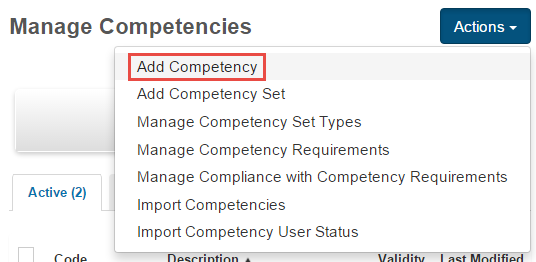
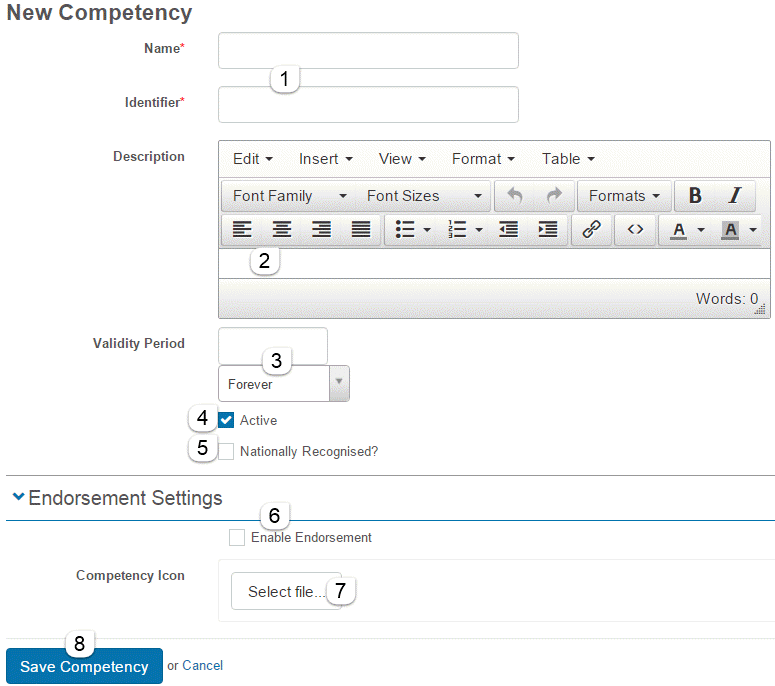
Extra Note about Validity:
If a Competency is defined as being valid for a certain period of time, it expires after this period is over. This period of time is measured from the date the User completes the linked learning asset and acquires the Competency.
Thus, a User holding a Competency will lose the Competency after the validity period is over.
To delete or archive Competencies select Manage Learning > Manage Competencies. You will see a list of the existing Competencies and Competency Sets.
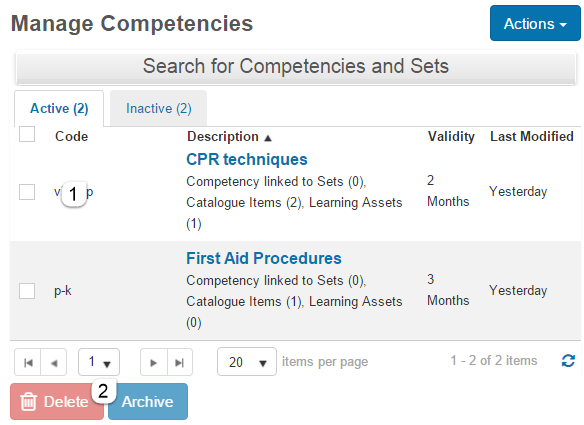
To Delete or Archive a Competency or Competency Set:
To perform this action on all Competencies and Competency Sets, select the Code check box, then select Delete or Archive as required.
Note:
To edit a Competency select its name. This takes you to its details page, where you can select Edit Competency.
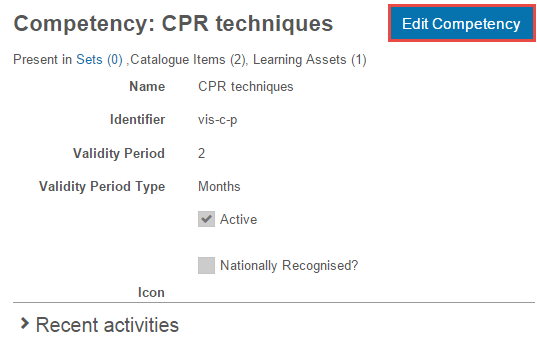
Editing a Competency allows you to change any of the values that were entered when the Competency was created. See Add a Competency for details.
Note
You can link Competencies to Catalogue Items, Courses and Assignments. The first of these is the most common.
A User acquires one or more Competencies or Competency sets when they complete the learning that has been linked to them.
To link Competency to a Catalogue Item navigate to Manage Learning > Manage Catalogue, locate the required Catalogue Item and select it.
Select Edit Catalogue Item from the Actions dropdown.

Select the Competencies collapsible window to open it.
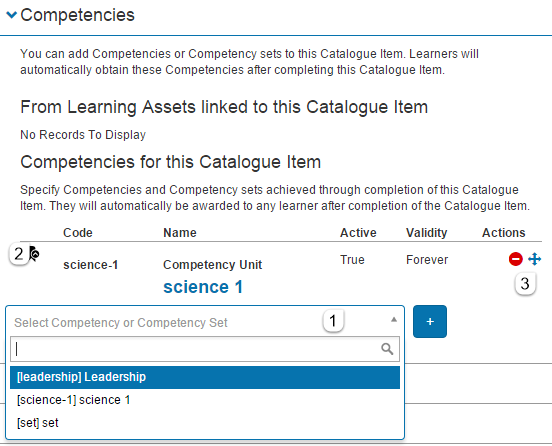
Note that there is no indication whether a list item is a Competency or Competency Set.
Select Save Catalogue Item when you have finished.
Note:
To link Competency to a Course follow the steps to edit the Course and select Competencies to open the collapsible window.
Follow the steps 1-3 for linking Competency to a Catalogue Item and save the Course.
To link Competency to an Assignment edit the Assignment and select Competencies to open the collapsible window.
Follow steps 1-3 for linking Competency to a Catalogue Item.
There is an additional option for Assignments where you must specify whether to automatically award Competencies when the learner passes the Assignment or whether the facilitator manually awards the Competencies if they were demonstrated in the Assignment.

Save the Assignment.
If you link learning to a Competency that is not valid forever, the Competency needs to be renewed periodically. Thus, the Catalogue Item (or Catalogue Item that the Learning Asset is linked to) must allow re-enrolments so that Users can re-enrol in the Catalogue Item and re-acquire the Competency.
You can link Competencies to Catalogue Items, Courses and Assignments. The first of these is the most common.
A User acquires one or more Competencies or Competency sets when they complete the learning that has been linked to them.
To link Competency to a Catalogue Item navigate to Manage Learning > Manage Catalogue, locate the required Catalogue Item and select it.
Select Edit Catalogue Item from the Actions dropdown.

Select the Competencies collapsible window to open it.

Note that there is no indication whether a list item is a Competency or Competency Set.
Select Save Catalogue Item when you have finished.
Note:
To link Competency to a Course follow the steps to edit the Course and select Competencies to open the collapsible window.
Follow the steps 1-3 for linking Competency to a Catalogue Item and save the Course.
To link Competency to an Assignment edit the Assignment and select Competencies to open the collapsible window.
Follow steps 1-3 for linking Competency to a Catalogue Item.
There is an additional option for Assignments where you must specify whether to automatically award Competencies when the learner passes the Assignment or whether the facilitator manually awards the Competencies if they were demonstrated in the Assignment.

Save the Assignment.
If you link learning to a Competency that is not valid forever, the Competency needs to be renewed periodically. Thus, the Catalogue Item (or Catalogue Item that the Learning Asset is linked to) must allow re-enrolments so that Users can re-enrol in the Catalogue Item and re-acquire the Competency.
Competency Requirements are collections of Competencies that are set up so that Users are required to acquire the Competencies. Completion of the appropriate learning has to be done periodically for Competencies that are only valid for a fixed period.
To manage Competency Requirements select Manage Learning > Manage Competencies and select Manage Competency Requirements from the Actions dropdown.

You will be directed to the Manage Competency Requirements screen.
To add a Competency Requirement, select Add Competency Requirement from the top of the page.

You will be directed to the New Competency Requirement screen.
This adds the Competency to the list. You can do this multiple times.
Rather than selecting multiple User names from a dropdown, you create rules to define the Users who this Competency Requirement apples to. These rules are called filters. They can be very specifically targeted and are combined using Boolean logic. This will be best understood by someone who is comfortable with:
Clear, detailed instructions about how to set these up are found at Building Filters.
Follow these instructions to create filter(s) to specify the required Users.

Important Note:
The Competency Requirement that you just created has not actually been applied to the Users you specified until you Run Requirements and link all active Competency Requirements to their Users.
A Competency Requirement is not actually linked to the Users it specifies until you Run Requirements.
To do this select Manage Learning > Manage Competencies and then select Manage Competency Requirements from the Actions dropdown.

This takes you to the Manage Competency Requirements screen.
Select Run Requirements. This will process all active Competency Requirements.

After you have Run Requirements, you should notice that the number next to Affects Users has changed for new Competency Requirements, because Users have just been linked to the Requirement.

Important Note:
If you have edited a Competency Requirement so that Users who were previously selected by filter(s) are no longer selected, then after you Run Requirements those Users will no longer have the Competency Requirement attached to them. The same applies if you remove Competencies from the Competency Requirement. In other words, Run Requirements always starts from scratch.
To edit a Competency Requirement select Manage Learning > Manage Competencies.
Select Manage Competency Requirements from the Actions dropdown.

Select the name of the Competency Requirement you want to edit. This takes you to its details screen.
Select Edit a Competency Requirement.

This takes you to the edit screen where you can change any of the values entered when the Competency Requirement was created. See Add a Competency Requirement for details.
Notes
Follow the steps to edit a Competency Requirement and then select Delete Competency Requirement.

You can view User compliance with active Competency Requirements. The information is displayed as charts, lists and numbers and can be subdivided as required into data about particular Users, Organisation Units, Organisations, Groups and Competencies, as explained below.
To see this information select Manage Learning > Manage Competencies and select Manage Compliance with Competency Requirements from the Actions dropdown.

Compliance is divided into one of four categories, with Risk levels applied when nearing the expiry of a Competency, see Compliance classifications for details.
These categories are shown by colours:
 = Compliant
= Compliant
 = Low Risk
= Low Risk
 = High Risk
= High Risk
 = Non-Compliant
= Non-Compliant
Data is displayed about the Users who have Competency Requirements (CR) applied to them. Data is collected as requirements for Competency, i.e. the number of different Competencies involved and User Competency requirements, i.e. the number of separate requirements of a User for Competency.
To explain the screen display, we are using two examples here. In the first example, it is February the 29th and there is one User with one CR applied to her. This CR contains three Competencies. One Competency lasts forever and the other two have expiry dates. The User acquired all the Competencies in February, just before the Manage Compliance with Competency Requirements screen was produced.
Thus, there are three separate User Competency requirements in the active CR system because the User is required to have three Competencies. As there are three Competencies in the active CR system, there are three requirements for Competency. Do not confuse this with the fact that there is one active Competency Requirement (CR).
This screenshots below show all Users and all Competencies involved in active CRs:
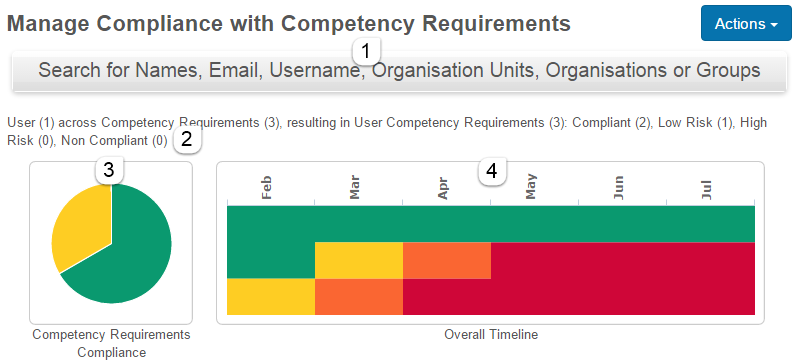
Moving the cursor over the timeline creates popups showing how compliance data changes over time as the Competencies approach their expiry dates.
We can see below that in April, one User Competency requirement is Compliant (green), one High Risk (orange) and one Non-Compliant (red).

Remember that the User acquired all three Competencies in February but each one has a different validity period, as we will see below.

In this simple example, the top half of the screen below does not give any extra information because there is only one User in the entire system. The Details area is more useful and shows the date that each of the User’s Competencies was acquired and its expiry date.
Next month it will be classified as Low-Risk, the following month it will be High Risk, and so on.

The bottom part of the Manage Compliance with Competency Requirements screen summarises the data per Competency.

In a more complex example, it is still February but there are four Users with Competency Requirements (CR) applied to them.
There are three different CRs in this system, each with a unique Competency. So there are three separate Competencies involved and hence three requirements for Competency. As before, one Competency lasts forever and the other two have expiry dates. Users who have acquired their Competency did so in February.
In this example each CR is linked to one Competency and each User has only been linked to one CR. Thus per User, there is only one User Competency requirement, giving a total of four User Competency requirements in the system.
The Manage Compliance with Competency Requirements screen shows all Users and all Competencies involved in active CRs.

Remember that in this example all Users acquired their Competency in February but each of the three Competencies has a different expiry period.

In the case of Nash Connors, View More shows:
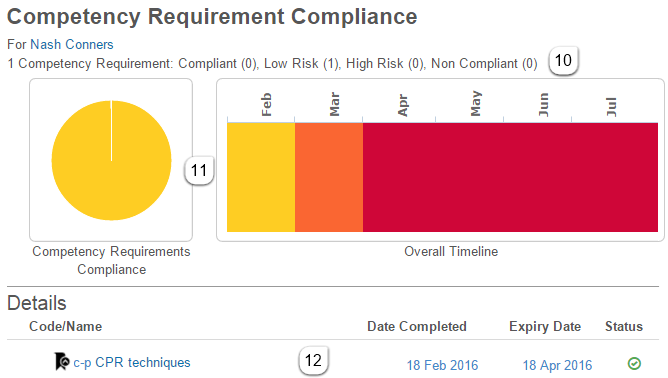

Notes:
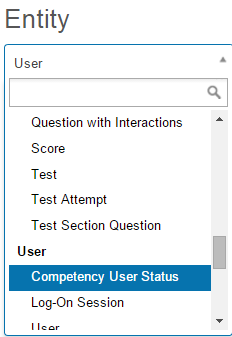
A User is compliant in relation to a particular Competency – at a particular point in time – if they have a completed enrolment in the learning associated with the Competency and either:
The User is classified as Compliant when compliant in relation to the Competency and this will be true for 2 months or more into the future.
The risk classifications are defined as:
The User is Non Compliant when:
Sometimes you need to create a set of Competencies, such as an in-house collection of competencies. These are called Competency Sets.
Notes
To add a Competency Set, select Manage Learning > Manage Competencies and select Add Competency Set from the Actions dropdown.

You can do this multiple times.

You may require more than the default Competency Set Type. If so, you can add new Set Types.
Select Manage Learning > Manage Competencies and then select Manage Competency Set Types from the Actions dropdown.
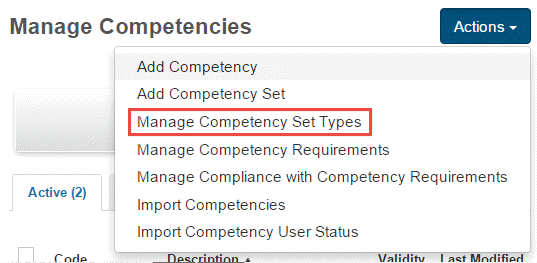
Select Add Competency Set Type.
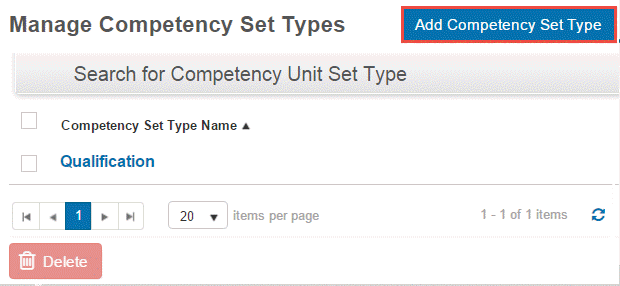
This takes you to the New Competency Set Type screen.
Add a Name and a Description for this Competency Set Type.
Select Save Competency Set Type.
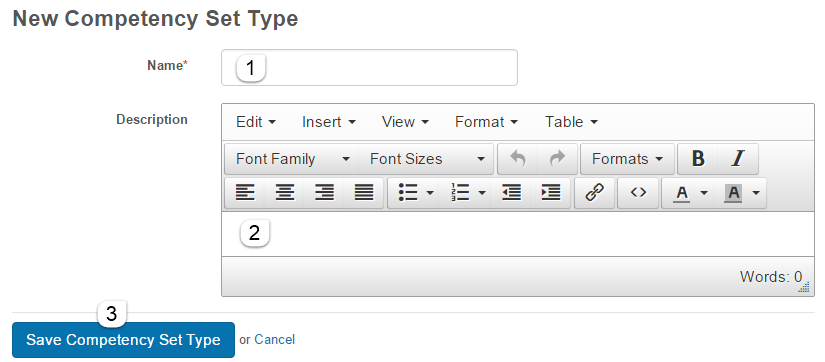
The Assign Competency Wizard must be enabled before it can be used to assign competencies to users.

The Assign Competency Wizard can be used to assign one or more competencies to one or more users.
Note the following prerequisites:

Each competency being assigned to a user will be listed under Competency Details. Any expiry date, as specified in the competency’s settings, will be shown.
The details of the competencies that have been assigned will be listed. No notifications are sent when competencies are assigned.
Competencies achieved can be visible both to learners and to their managers.
To view their Competencies a learner selects My Account and follows the steps below.
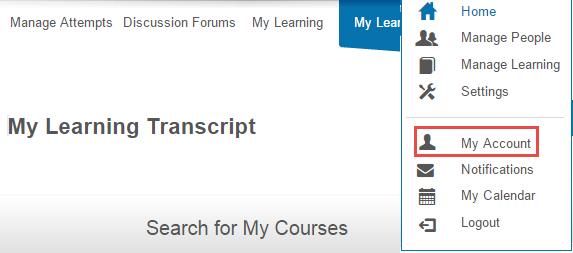
Three tabs appear: Required, Enrolled and Achieved.
If a Competency has been acquired the Date Completed and Expiry Dates are shown and the Status icon is a tick.
If it has not been completed, these dates are blank and the Status icon is red with a crossbar
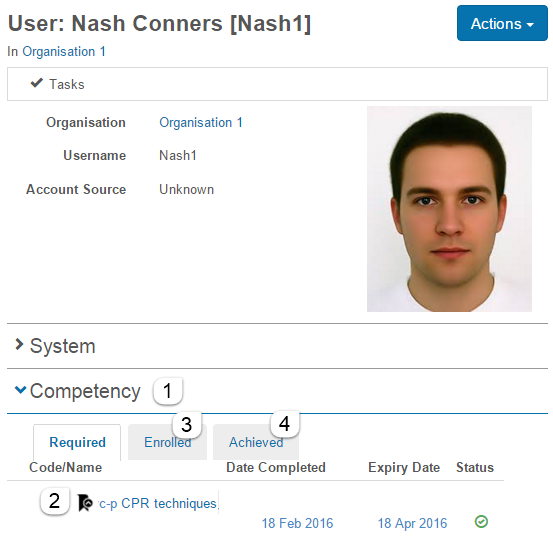
Under specific circumstances a User can see the Competency Requirement status of their staff on their My Learning screen.
To enable this:
When these are set, a Competency Requirement tile appears at the bottom of the screen:
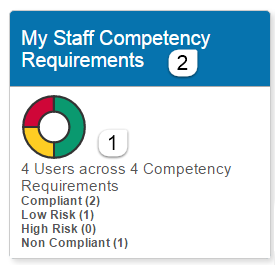
Note: If you have set this up correctly and do not see the tile, contact Support for help.
Rather than entering Competencies into the CLS system one at a time using Add a Competency, you can import a batch of Competencies using a spreadsheet.
To do this, select Manage Learning > Manage Competencies and select Import Competencies from the Actions dropdown.
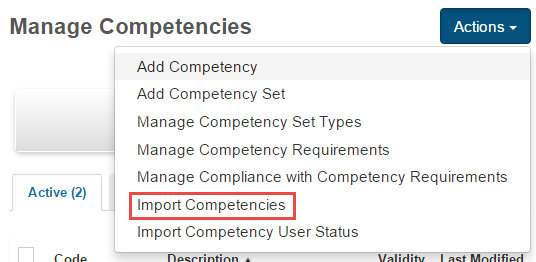

You may have information about when Users acquired certain Competencies and you wish to import it into the CLS system. This can be done using a spreadsheet.
To do so select Manage Learning > Manage Competenciesthen select Import Competency User Status from the Actions dropdown.
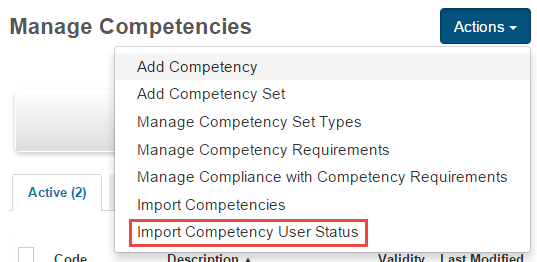

1300 857 687 (Australia)
+61 2 6652 9850 (International)
ACN 091 302 975
ABN 35 081 897 494
© 2024 Janison
Janison acknowledges the traditional owners of the land on which we work and meet. We acknowledge the continuous care of the land, animals and waterways. We pay our respects to Elders past, present and emerging.